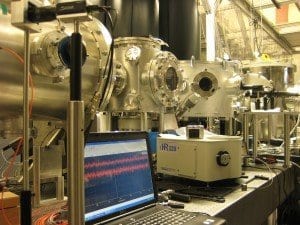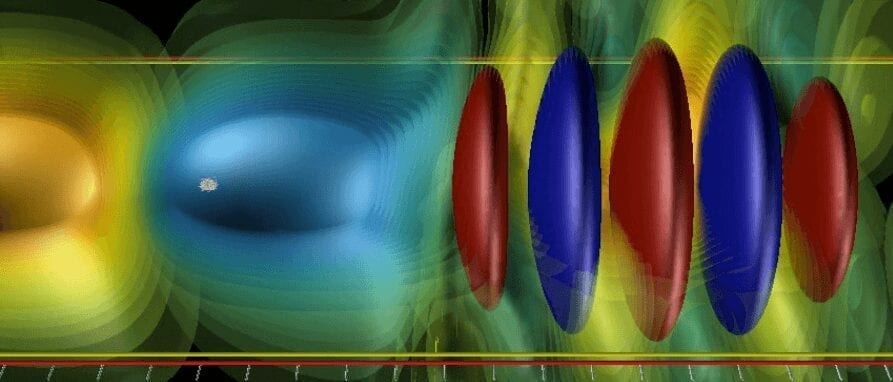
Physicists at The University of Texas at Austin have built a tabletop particle accelerator that can generate energies and speeds previously reached only by major facilities that are hundreds of meters long and cost hundreds of millions of dollars to build.
“We have accelerated about half a billion electrons to 2 gigaelectronvolts over a distance of about 1 inch,” said Mike Downer, professor of physics in the College of Natural Sciences. “Until now that degree of energy and focus has required a conventional accelerator that stretches more than the length of two football fields. It’s a downsizing of a factor of approximately 10,000.”
The results, which were published this week in Nature Communications, mark a major milestone in the advance toward the day when multi-gigaelectronvolt (GeV) laser plasma accelerators are standard equipment in research laboratories around the world.
Downer said he expects 10 GeV accelerators of a few inches in length to be developed within the next few years, and he believes 20 GeV accelerators of similar size could be developed within a decade.
Downer said that the electrons from the current 2 GeV accelerator can be converted into “hard” X-rays as bright as those from large-scale facilities. He believes that with further refinement they could even drive an X-ray free electron laser, the brightest X-ray source currently available to science.
A tabletop X-ray laser would be transformative for chemists and biologists, who could use the bright X-rays to study the molecular basis of matter and life with atomic precision, and femtosecond time resolution, without traveling to a large national facility.
“The X-rays we’ll be able to produce are of femtosecond duration, which is the time scale on which molecules vibrate and the fastest chemical reactions take place,” said Downer. “They will have the energy and brightness to enable us to see, for example, the atomic structure of single protein molecules in a living sample.”
To generate the energetic electrons capable of producing these X-rays, Downer and his colleagues employed an acceleration method known as laser-plasma acceleration. It involves firing a brief but intensely powerful laser pulse into a puff of gas.
“To a layman it looks like low technology,” said Downer. “All you do is make a little puff of gas with the right density and profile. The laser pulse comes in. It ionizes that gas and makes the plasma, but it also imprints structure in it. It separates electrons from the ion background and creates these enormous internal space-charge fields. Then the charged particles emerge right out of the plasma, get trapped in those fields, which are racing along at nearly the speed of light with that laser pulse, and accelerate in them.”
Downer compared it to what would happen if you threw a motorboat into a lake with its engines churning. The boat (the laser) makes a splash, then creates a wave as it moves through the lake at high speed. During that initial splash some droplets (charged particles) break off, get caught up in the wave and accelerate by surfing on it.
“At the other end of the lake they get thrown off into the environment at incredibly high speeds,” said Downer. “That’s our 2 GeV electron beam.”
The Latest Bing News on:
Particle accelerator
- First bison babies of year born at Fermilab: ‘Calving season is the most rewarding time of the year’on April 26, 2024 at 5:20 pm
Two bison were born Friday at Fermi National Accelerator Laboratory in Batavia. The facility's 30-acre pasture has long been home to the grazing mammals.
- IceCube researchers detect a rare type of particle sent from powerful astronomical objectson April 25, 2024 at 8:28 am
The tau neutrino, one type of particularly energetic neutrino, has eluded IceCube's detectors on the South Pole – until now.
- Scientists are one step closer to knowing the mass of ghostly neutrinos — possibly paving the way to new physicson April 19, 2024 at 2:00 am
By precisely measuring the mass of neutrinos — ghostly particles that stream through your body by the billions each second — physicists could find some glaring holes in the Standard Model of particle ...
- DOE Awards $16M for Traineeships in Accelerator Science & Engineeringon April 18, 2024 at 1:16 pm
Today, the U.S. Department of Energy (DOE) announced $16 million in funding for four projects providing classroom training and research opportunities to train the next generation of accelerator ...
- Smoother surfaces make for better acceleratorson April 18, 2024 at 1:03 pm
With every new particle accelerator built for research, scientists have an opportunity to push the limits of discovery. But this is only true if new particle accelerators deliver the desired ...
- Physics vocabulary: AI editionon April 17, 2024 at 11:58 pm
AI also plays an increasingly big role in particle physics and astrophysics, allowing scientists to control particle accelerators with unprecedented precision and analyze almost instantaneously ...
- Smoother surfaces make for better acceleratorson April 17, 2024 at 5:00 pm
This orientation map of a nitrogen-doped sample of niobium shows the formation of niobium nitrides (rainbow-colored shards) within grains and along grain boundaries (the grain boundaries shown are ...
- Symmetry’s guide to AI in particle physics and astrophysicson April 17, 2024 at 6:01 am
Symmetry will explore the ways scientists are using artificial intelligence to advance particle physics and astrophysics—in a series of articles written and illustrated entirely by humans.
- SURF glides to 800Gbps transmission on existing fibre through Nokiaon April 15, 2024 at 11:32 pm
Nokia and Dutch research organisation SURF reach 800Gbps transmission over 1,648km existing fibre link to prepare for upgrade to connect to research facilities at world’s leading particle accelerator.
- Peter Higgs, physicist who unlocked mysteries of the universe, dies aged 94on April 9, 2024 at 4:51 am
Higgs, who died peacefully at home on Monday, saw the groundbreaking theoretical work he and others did in the 1960s triumphantly confirmed by experiments at the Cern particle accelerator almost ...
The Latest Google Headlines on:
Particle accelerator
[google_news title=”” keyword=”particle accelerator” num_posts=”10″ blurb_length=”0″ show_thumb=”left”]
The Latest Bing News on:
Tabletop particle accelerator
- Machine learning and experimenton April 25, 2024 at 5:31 am
For more than 20 years in experimental particle physics and astrophysics, machine learning has been accelerating the pace of science, helping scientists tackle problems of greater and greater ...
- Smoother surfaces make for better acceleratorson April 18, 2024 at 1:03 pm
With every new particle accelerator built for research, scientists have an opportunity to push the limits of discovery. But this is only true if new particle accelerators deliver the desired ...
- Peter Higgs, Nobel Prize-winning physicist who predicted the Higgs boson, dies at 94on April 9, 2024 at 1:53 pm
Celebrated theoretical physicist Peter Higgs, best known for predicting the existence of the Higgs boson, has died at the age of 94 after a short illness.
The Latest Google Headlines on:
Tabletop particle accelerator
[google_news title=”” keyword=”tabletop particle accelerator” num_posts=”10″ blurb_length=”0″ show_thumb=”left”]










